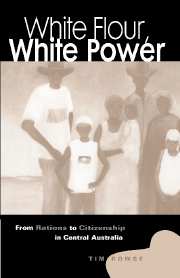Book contents
6 - The World War in Town and Hinterland
from PART TWO
Published online by Cambridge University Press: 23 October 2009
Summary
The Second World War made Alice Springs and the north-south transport corridor between Adelaide and Darwin strategically important to colonial authorities. Settlers came in unprecedented numbers to the region – up to 10,000 soldiers and civilians in Alice Springs and more along the Stuart Highway – leading authorities to adopt a more comprehensive and systematic approach to the supervision of Indigenous people. The war increased the demand for their labour, and it posed anew the problems of public hygiene and good order in relationships between the Indigenous and settler populations.
In combination, these exigencies heightened the tendency of colonial authority to favour, as the chief instrument of ‘welfare’, the segregation of the colonised from the colonists. As noted, police ceased to ration in Alice Springs in November 1940, and those who had got rations in town were required to live at Jay Creek. The Administration and the army combined to support the Finke River mission in setting up two ration points further west – Haasts Bluff and Areyonga – to stabilise hinterland people who were walking in to Jay Creek and Alice Springs. The Catholic (‘Little Flower’) mission was prevailed upon to disband the Charles Creek camp and to remove residents east to Arltunga. ‘Half-castes’ were taken from the old Telegraph Station to missions in the Top End of the Northern Territory, and later to institutions outside the cities of Adelaide and Sydney.
- Type
- Chapter
- Information
- White Flour, White PowerFrom Rations to Citizenship in Central Australia, pp. 92 - 104Publisher: Cambridge University PressPrint publication year: 1998



